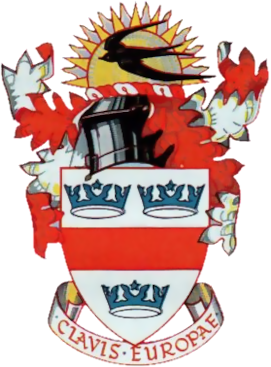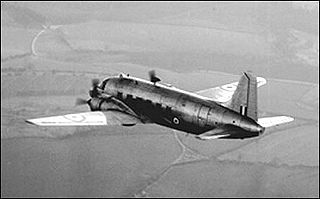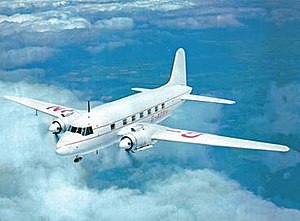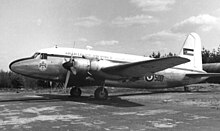
The Airspeed AS.57 Ambassador is a British twin piston-engined airliner that was designed and produced by the British aircraft manufacturer Airspeed Ltd. It was one of the first postwar airliners to be produced.

The Sud Aviation SE 210 Caravelle is a French jet airliner produced by Sud Aviation. It was developed by SNCASE in the early 1950s, and made its maiden flight on May 27, 1955. It included some de Havilland designs and components developed for the de Havilland Comet. SNCASE merged into the larger Sud Aviation conglomerate before the aircraft entered revenue service on April 26, 1959, with Scandinavian Airlines System (SAS); 282 were built until production ended in 1972. It was ordered by airlines on every continent and operated until its retirement in 2005.

The Bristol Type 175 Britannia is a retired British medium-to-long-range airliner built by the Bristol Aeroplane Company in 1952 to fly across the Commonwealth. During development two prototypes were lost and the turboprop engines proved susceptible to inlet icing, which delayed entry into service while solutions were sought.

British European Airways (BEA), formally British European Airways Corporation, was a British airline which existed from 1946 until 1974.

The Vickers VC10 is a mid-sized, narrow-body long-range British jet airliner designed and built by Vickers-Armstrongs (Aircraft) Ltd and first flown at Brooklands, Surrey, in 1962. The VC10 is often compared to the larger Soviet Ilyushin Il-62, the two types being the only airliners to use a rear-engined quad layout, while the smaller business jet Lockheed JetStar also has this engine arrangement.

The Vickers Vanguard was a short/medium-range turboprop airliner designed and produced by the British aircraft manufacturer Vickers-Armstrongs.
This is a list of aviation-related events from 1953:
This is a list of aviation-related events from 1954:

The Avro York was a British transport aircraft developed by Avro during the Second World War. The design was derived from the Avro Lancaster heavy bomber, several sections of the York and Lancaster being identical. Due to the importance of Lancaster production, York output proceeded slowly until 1944, after which a higher priority was placed upon transport aircraft.

The de Havilland DH.114 Heron is a small propeller-driven British airliner that first flew on 10 May 1950. It was a development of the twin-engine de Havilland Dove, with a stretched fuselage and two more engines. It was designed as a rugged, conventional low-wing monoplane with tricycle undercarriage that could be used on regional and commuter routes. A total of 149 were built; it was also exported to about 30 countries. Herons later formed the basis for various conversions, such as the Riley Turbo Skyliner and the Saunders ST-27 and ST-28.

The Lockheed Model 14 Super Electra was an American civil passenger and cargo aircraft built by the Lockheed Aircraft Corporation during the late 1930s. An outgrowth of the earlier Model 10 Electra, the Model 14 was also developed into larger, more capable civil and military versions.

The de Havilland DH.104 Dove is a British short-haul airliner developed and manufactured by de Havilland. The design, which was a monoplane successor to the pre-war Dragon Rapide biplane, came about from the Brabazon Committee report which, amongst other aircraft types, called for a British-designed short-haul feeder for airlines.

Airwork Limited, also referred to during its history as Airwork Services Limited, is a wholly owned subsidiary company of VT Group plc. It has a long and rich history in providing a variety of defence support services to the Royal Air Force (RAF), Fleet Air Arm and overseas air forces, as well as having played an important role in the development of civil aviation – both in the United Kingdom and abroad.

The Vickers Valetta is a twin-engine military transport aircraft developed and produced by the British manufacturing company Vickers-Armstrongs Ltd. Developed from the Vickers VC.1 Viking compact civil airliner, it was an all-metal mid-wing monoplane with a tailwheel undercarriage.
Central African Airways (CAA) was a supranational airline corporation serving as flag carrier for Southern Rhodesia, Northern Rhodesia and Nyasaland, which were organised as the Federation of Rhodesia and Nyasaland, also known as the Central African Federation, from 1953 to 1963. Based in Salisbury, it offered an extensive network of domestic passenger and cargo flights, as well as international services to major cities in Southern and Central Africa, and a route to London. In 1960, CAA owned 15 aircraft and had 1,155 employees.
Hunting-Clan Air Transport was a wholly private, British independent airline that was founded in the immediate post-World War II period. It began trading on 1 January 1946 as Hunting Air Travel Ltd. It was a subsidiary of the Hunting Group of companies, which had come from the shipping industry and could trace its history back to the 19th century. The newly formed airline's first operating base was at Bovingdon Airport in Southeast England. Its main activities were contract, scheduled and non-scheduled domestic and international air services that were initially operated with Douglas Dakota and Vickers Viking piston airliners from the company's Bovingdon base. A change of name to Hunting Air Transport occurred in 1951. By that time, the airline had emerged as one of the healthiest and most securely financed independent airlines in Britain.

The 1961 Holtaheia Vickers Viking crash was a controlled flight into terrain incident on 9 August 1961 at Holta in Strand, Norway. The Eagle Airways Vickers 610 Viking 3B Lord Rodney was en route from London Heathrow to Stavanger Airport, Sola on an AIR Tours charter flight taking a school group for a camping holiday. The aircraft was making an instrument landing when it crashed 54 km (34 mi) north east of Stavanger. All 39 people on board died.

On 5 January 1953, a Vickers Viking airliner operated by British European Airways crashed on approach to Belfast Nutts Corner Airport, Northern Ireland. The aircraft was on a domestic flight from London Northolt Airport with 31 passengers and 4 crew on board. Twenty-four of the passengers and three crew members died in the accident.

























